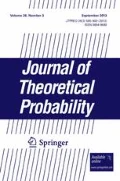Abstract
In this article, a uniform discretization of stochastic integrals \(\int _{0}^{1} f^{\prime }_-(B_t)\mathrm d B_t\), where \(B\) denotes the fractional Brownian motion with Hurst parameter \(H \in (\frac{1}{2},1)\), is considered for a large class of convex functions \(f\). In Azmoodeh et al. (Stat Decis 27:129–143, 2010), for any convex function \(f\), the almost sure convergence of uniform discretization to such stochastic integral is proved. Here, we prove \(L^r\)-convergence of uniform discretization to stochastic integral. In addition, we obtain a rate of convergence. It turns out that the rate of convergence can be brought arbitrarily close to \(H - \frac{1}{2}\).
Similar content being viewed by others
Notes
We have \(C=1\) except when \(a\in [0,1]\). In this case, \(C=e^{\frac{1}{2}}\).
References
Azmoodeh, E., Mishura, Y., Valkeila, E.: On hedging European options in geometric fractional Brownian motion market model. Stat. Decis. 27, 129–143 (2010)
Biagini, F., Campanino, M., Fuschini, S.: Discrete approximation of stochastic integrals with respect to fractional Brownian motion of Hurst index \(H > \frac{1}{2}\). Stochastics 80(5), 407–426 (2008)
Cheridito, P.: Mixed fractional Brownian motion. Bernoulli 7(6), 913–934 (2001)
Coutin, L., Nualart, D., Tudor, C.: Tanaka formula for the fractional Brownian motion. Stoch. Process. Appl. 94(2), 301–315 (2001)
Friz, P., Victoir, N.: Multidimensional Stochastic Processes as Rough Paths. Theory and Applications. Cambridge Studies of Advanced Mathematics. Cambridge University Press, Cambridge (2010)
Lifshits, M.A.: Gaussian Random Functions. Mathematics and its Applications, vol. 322. Kluwer, Dordrecht (1995)
Mishura, Y.: Stochastic Calculus for Fractional Brownian Motion and Related Processes. Lecture Notes in Mathematics, vol. 1929. Springer, Berlin (2008)
Nualart, D., Răşcanu, A.: Differential equations driven by fractional Brownian motion. Collect. Math. 53, 55–81 (2002)
Samko, S.G., Kilbas, A.A., Marichev, O.I.: Fractional Integrals and Derivatives, Theory and Applications. Gordon and Breach Science, Yvendon (1993)
Wasilkowski, G.W., Woźniakowski, H.: On the complexity of stochastic integration. Math. Comput. 70(234), 685–698 (2001)
Young, L.C.: An inequality of the Hölder type, connected with Stieltjes integration. Acta Math. 67, 251–282 (1936)
Zähle, M.: Integration with respect to fractal functions and stochastic calculus. Part I. Probab. Theory Relat. Fields 111, 333–372 (1998)
Acknowledgments
The authors thank Esko Valkeila for discussions and comments which improved the paper. The authors also thank anonymous referee for useful comments and remarks. Ehsan Azmoodeh thanks the Magnus Ehrnrooth foundation for financial support. Lauri Viitasaari thanks the Finnish Doctoral Programme in Stochastics and Statistics for financial support.
Author information
Authors and Affiliations
Corresponding author
Appendix: Proofs of Lemmas 3.1 and 3.2
Appendix: Proofs of Lemmas 3.1 and 3.2
We begin with the following lemma which we use in the proof.
Lemma 4.3
Let \(H>\frac{1}{2}\) and fix \(0<s\le t\le 1\). Put
Then, there exists a constant \(C\), such that
Proof
Note that since \(H>\frac{1}{2}\), we have \(R(s,s)\le R(t,s)\). Let now \(t>2s\). Then
Hence, it is sufficient to consider the case \(s\le t \le 2s\). In this case, we have
Hence, we only have to prove that
By putting \(k=\frac{t}{s}\), this is equivalent to
Now, we have \(k\in [1,2]\). Hence,
This completes the proof.\(\square \)
Proof of lemma 3.1
Let \(R(t,s)\) denotes the covariance function of fractional Brownian motion given by
We make use of decomposition
where \(Y\) is \(N(0,1)\) random variable independent of \(B_s\) and
Assume that
Then, we obtain
We begin with \(I_1\). By Lemma 4.2 we have
where \(A(x) = \frac{a-\frac{R(t,s)}{R(s,s)}x}{\sigma }\). Hence
Note that \(\sigma \le (t-s)^H\) and \(R(s,s)\le R(t,s)\), so it remains to show that the integral is bounded by a constant independent of \(s, t\) and \(a\). It is easy to see that
where
Now
and
Hence
Hence for \(I_1\), there exists a constant \(C\) such that
We proceed to study the term \(I_2\). Note that \(\sigma ^2\ge 0\). Hence
As a consequence, there exists a constantFootnote 1 \(C\) such that
for every \(a\) and every \(x\in \left[ \frac{R(s,s)}{R(t,s)}(a-1),a\right] \). Hence
By applying Tonelli’s theorem, the integral can be written as
For \(I_{2,2}\), by Lemma 4.2, we obtain
For \(I_{2,1}\), by applying Lemma 4.3, we obtain
Hence, we have the result. To conclude the proof, we note that if
then we proceed as for \(I_1\) and obtain the result.\(\square \)
Proof of lemma 3.2
By following the proof of Lemma 3.1, we obtain that for every \(H\ge \frac{1}{2}\)
Moreover, we have
The claim follows using the fact that when \(H=\frac{1}{2}\), we have \(R(s,s)=R(t,s)\) for \(s \le t\). Hence,
and
\(\square \)
Rights and permissions
About this article
Cite this article
Azmoodeh, E., Viitasaari, L. Rate of Convergence for Discretization of Integrals with Respect to Fractional Brownian Motion. J Theor Probab 28, 396–422 (2015). https://doi.org/10.1007/s10959-013-0495-y
Received:
Revised:
Published:
Issue Date:
DOI: https://doi.org/10.1007/s10959-013-0495-y


